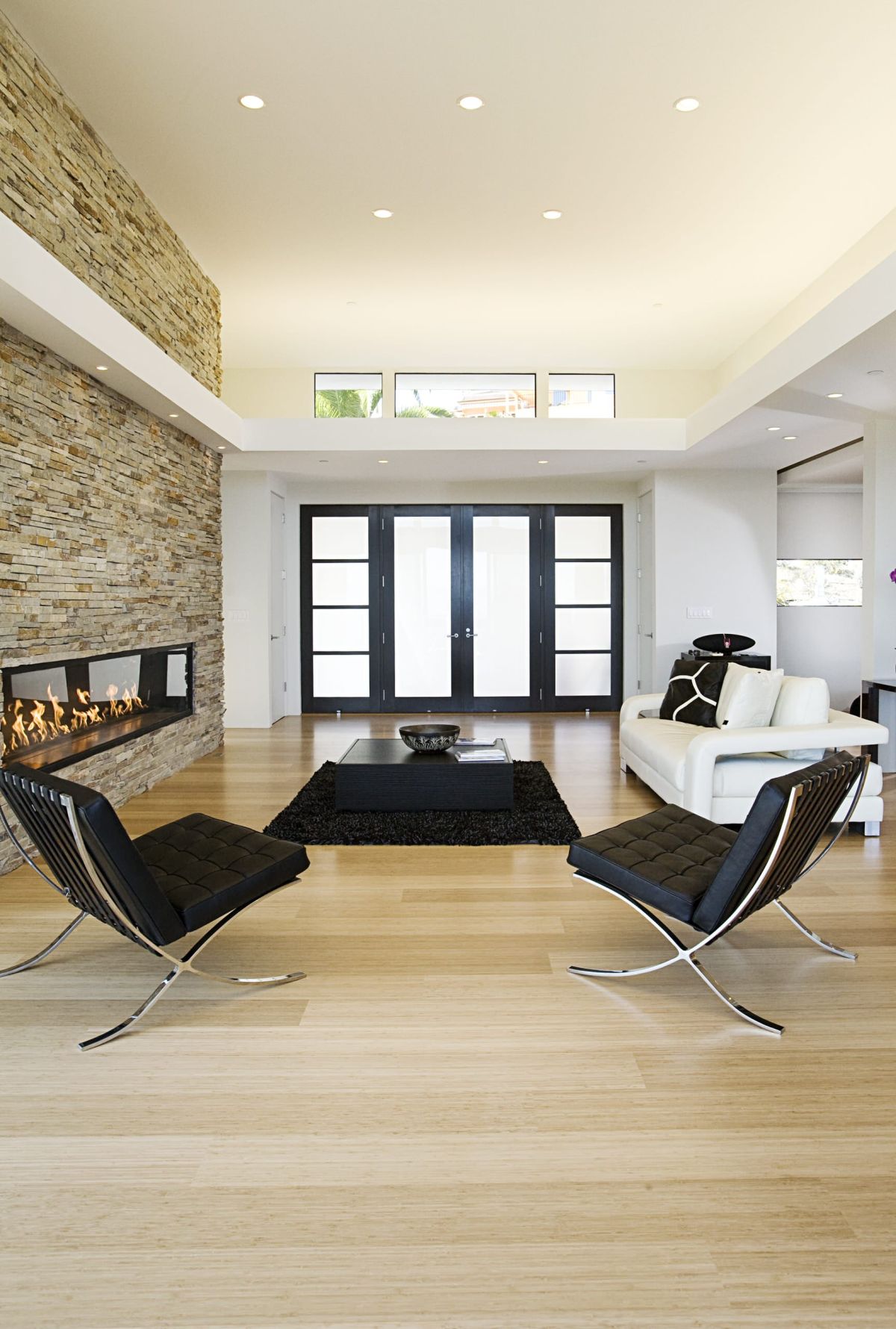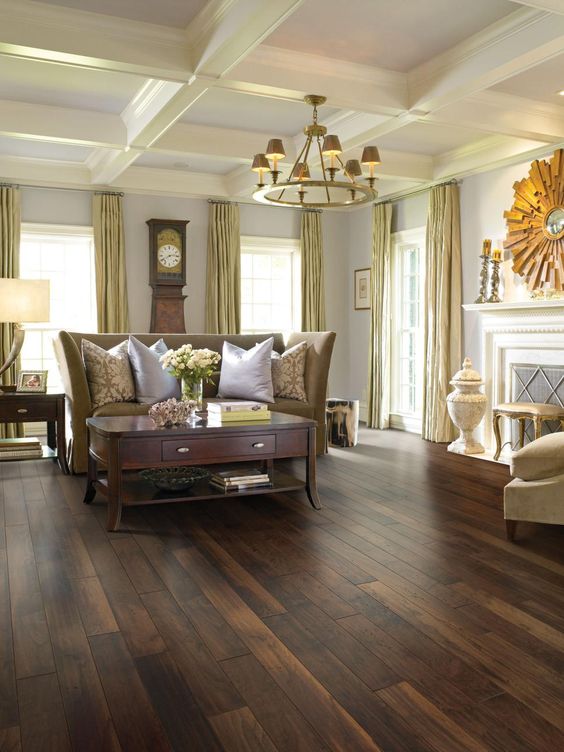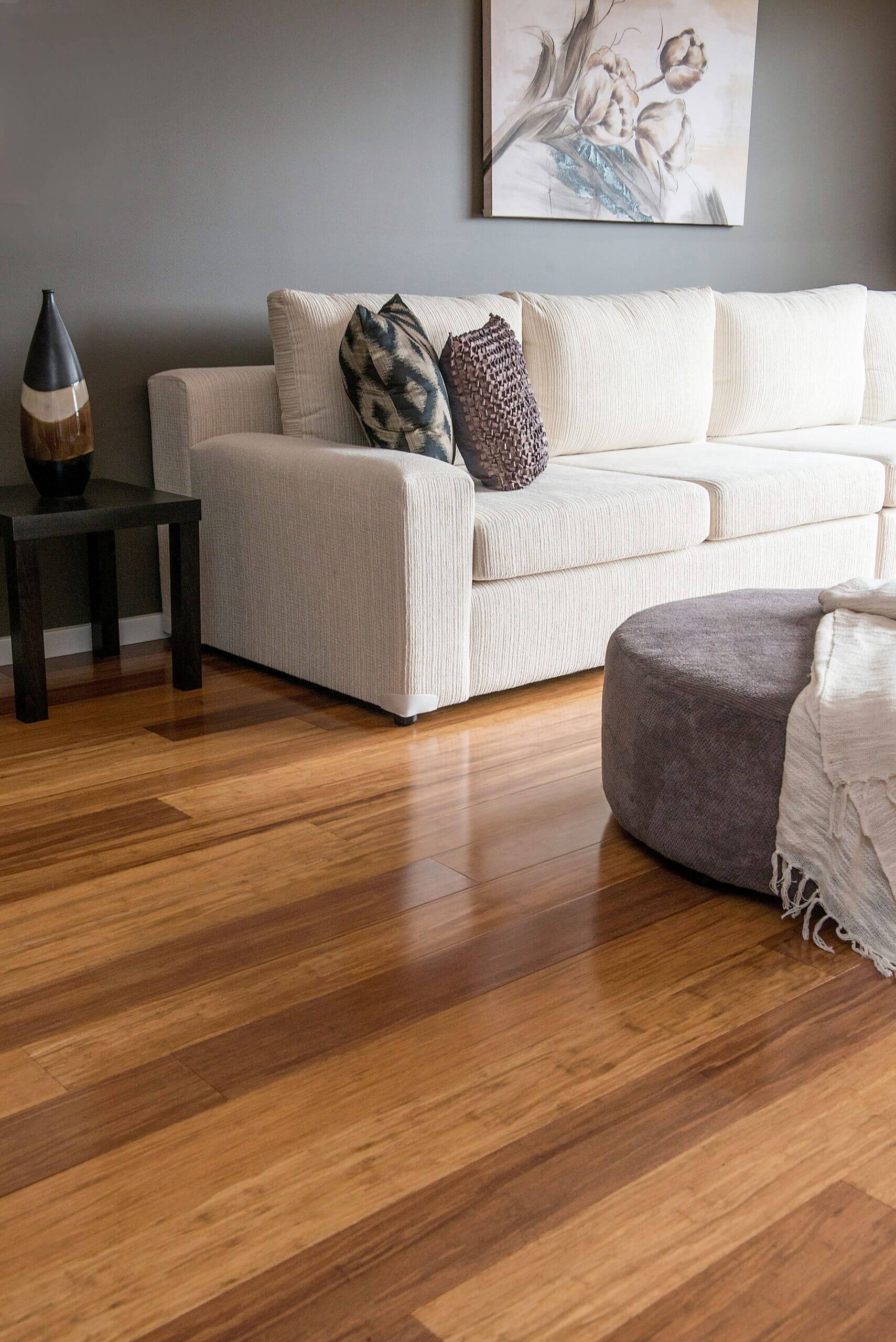The Benefits of Bamboo Flooring in Your Living Room
Bamboo flooring has gained popularity in recent years, and for good reason. It’s not only a stylish and modern option for your living room, but it also comes with a host of benefits that make it an excellent choice for homeowners looking to upgrade their space. Below are some of the key benefits that bamboo flooring can bring to your living room.
- Eco-Friendly and Sustainable: Bamboo is one of the most environmentally friendly flooring options available. Unlike hardwood trees, which can take decades to mature, bamboo is a fast-growing grass that can be harvested in just three to five years. This rapid growth rate makes bamboo a highly renewable resource. Additionally, bamboo can be grown without the need for pesticides or fertilizers, reducing its environmental impact even further. Choosing bamboo flooring for your living room is a step towards a more sustainable home.
- Durability and Strength: Despite being a type of grass, bamboo flooring is incredibly strong and durable. In fact, strand-woven bamboo flooring is known to be one of the hardest flooring options available, often outlasting traditional hardwood floors. This durability makes bamboo an excellent choice for high-traffic areas like living rooms, where floors can take a lot of wear and tear from daily activities.
- Aesthetic Appeal: Bamboo flooring offers a unique and elegant look that can enhance the aesthetic of any living room. Its natural grain patterns and warm tones create a welcoming and sophisticated atmosphere. Bamboo flooring also comes in a variety of finishes and colors, allowing you to choose a style that perfectly complements your living room decor.
- Easy Maintenance: Maintaining bamboo flooring is relatively simple, making it an ideal choice for busy households. Regular sweeping or vacuuming and occasional mopping with a damp cloth are usually all that’s needed to keep your bamboo floors looking their best. Additionally, bamboo is naturally resistant to stains and water damage, further simplifying the maintenance process.
- Affordability: Bamboo flooring is often more affordable than traditional hardwood flooring. This cost-effectiveness makes it an attractive option for homeowners looking to achieve a high-end look without breaking the bank. The lower price point does not mean you have to compromise on quality, as bamboo flooring offers excellent durability and longevity at a fraction of the cost.
- Allergen-Friendly: Bamboo flooring is a great option for households with allergy sufferers. Unlike carpet, which can trap dust, pollen, and other allergens, bamboo floors have a smooth surface that doesn’t harbor these irritants. This helps to improve indoor air quality and create a healthier living environment for you and your family.

Different Types of Bamboo Flooring: Which is Best for Your Space?
When it comes to bamboo flooring, there are several types to choose from, each with its unique characteristics. Understanding the differences between these types can help you select the best option for your living room. Below, we explore the main types of bamboo flooring and their respective benefits.
Horizontal Bamboo Flooring
Horizontal bamboo flooring is made by stacking bamboo strips horizontally, showing off the natural grain of the bamboo. This type of flooring highlights the knots and growth patterns of the bamboo, giving it a distinctive, natural look. If you’re aiming for a more rustic or organic feel in your living room, horizontal bamboo flooring might be the best choice for you.
Vertical Bamboo Flooring
Vertical bamboo flooring is created by stacking bamboo strips vertically, which results in a more uniform and linear appearance. This type of flooring has a sleeker, more modern look, making it ideal for contemporary living room designs. The uniformity of vertical bamboo flooring allows it to blend seamlessly with a variety of decor styles.
Strand-Woven Bamboo Flooring
Strand-woven bamboo flooring is made by compressing shredded bamboo fibers under intense pressure. This process creates an extremely hard and durable flooring option, making it one of the toughest on the market. Strand-woven bamboo flooring is perfect for high-traffic areas like living rooms, where durability is a key consideration. It also offers a unique, textured appearance that adds character to your space.
Engineered Bamboo Flooring
Engineered bamboo flooring consists of a bamboo veneer on top of a plywood or fiberboard base. This type of flooring is designed to be more stable than solid bamboo flooring, making it a good choice for areas with fluctuating humidity levels. Engineered bamboo flooring is also easier to install and can often be floated over existing flooring, making it a convenient option for renovations.
Carbonized Bamboo Flooring
Carbonized bamboo flooring undergoes a heating process that darkens the bamboo, giving it a rich, amber color. This type of flooring is ideal if you prefer a warmer, more traditional look in your living room. However, it’s important to note that the carbonization process can slightly soften the bamboo, so it may not be as durable as non-carbonized options.
Natural Bamboo Flooring
Natural bamboo flooring retains the bamboo’s original color, offering a lighter, more neutral tone. This type of flooring is versatile and can complement a wide range of living room styles, from minimalist to Scandinavian. Its natural hue makes it an excellent choice for creating a bright and airy atmosphere in your living room.
How to Choose the Right Bamboo Flooring Finish for Your Living Room
Choosing the right finish for your bamboo flooring is just as important as selecting the type of bamboo. The finish not only affects the appearance of your floors but also their durability and ease of maintenance. Here’s a guide to help you choose the best finish for your living room bamboo flooring.
Matte Finish
A matte finish provides a soft, natural look to your bamboo flooring, making it a great choice if you want to highlight the natural beauty of the bamboo. This finish has a low sheen, which helps to conceal scratches and imperfections, making it ideal for high-traffic living rooms. The matte finish also gives your living room a more relaxed, understated feel.
Satin Finish
A satin finish strikes a balance between a matte and glossy finish, offering a moderate sheen that adds a touch of elegance to your living room. This finish is popular for its versatility, as it complements both traditional and modern decor styles. A satin finish is also easy to maintain, as it doesn’t show dirt and dust as much as a high-gloss finish.
Glossy Finish
A glossy finish gives your bamboo flooring a shiny, reflective surface, which can make your living room look more spacious and bright. This finish is perfect for contemporary or formal living room designs where a polished look is desired. However, it’s important to note that a glossy finish can show scratches and wear more easily, so it may require more maintenance to keep it looking pristine.
Hand-Scraped Finish
A hand-scraped finish adds texture and character to your bamboo flooring, giving it a rustic, vintage look. This finish is created by hand, with each plank being individually scraped to create a unique surface. The hand-scraped finish is perfect for living rooms with a farmhouse or shabby chic decor, as it adds warmth and charm to the space.
Distressed Finish
A distressed finish is designed to mimic the look of aged or reclaimed wood. This finish features intentional imperfections, such as dents, scratches, and knots, giving the bamboo flooring a weathered, lived-in appearance. If you’re going for an industrial or eclectic style in your living room, a distressed finish can add a lot of character and visual interest.
Natural Finish
A natural finish preserves the original color and texture of the bamboo, offering a minimalist and eco-friendly option for your living room. This finish is often achieved with a light application of oil or wax, which enhances the bamboo’s natural beauty while providing a protective layer. A natural finish is ideal for those who prefer a more organic, unprocessed look in their living space.
Installation Tips for Bamboo Flooring in Living Rooms
Installing bamboo flooring in your living room can be a rewarding DIY project, but it requires careful planning and attention to detail. Whether you’re a seasoned DIYer or a first-time installer, these tips will help you achieve a professional-looking finish.
Prepare the Subfloor
Before installing bamboo flooring, it’s crucial to ensure that the subfloor is clean, dry, and level. Any debris or imperfections can affect the installation and lead to issues down the line. Use a moisture meter to check the subfloor’s moisture levels, as excessive moisture can cause bamboo flooring to warp or buckle. If necessary, install a moisture barrier to protect your bamboo flooring.
Acclimate the Bamboo Flooring
Bamboo flooring needs to acclimate to the room’s temperature and humidity levels before installation. This process typically takes 72 hours, during which you should leave the bamboo planks in the living room where they will be installed. This step helps to prevent expansion or contraction after installation, ensuring a stable and long-lasting floor.
Choose the Right Installation Method
There are several methods for installing bamboo flooring, including nail-down, glue-down, and floating. The best method for your living room will depend on the type of bamboo flooring you’ve chosen and the condition of your subfloor. Nail-down installation is ideal for solid bamboo flooring, while engineered bamboo is often installed using the floating method. Glue-down installation provides added stability but can be more time-consuming.
Plan Your Layout
Before you start installing, take the time to plan the layout of your bamboo flooring. Consider the direction of the planks, as running them parallel to the longest wall or the direction of natural light can create a more visually appealing result. You should also stagger the joints of the planks to avoid a uniform appearance, which can look unnatural. Make sure to leave a small gap around the edges of the room to allow for expansion.
Use Proper Tools and Techniques
Using the right tools and techniques is key to a successful bamboo flooring installation. You’ll need a saw to cut the planks to size, a tape measure, and a rubber mallet to tap the planks into place. When cutting the planks, measure carefully to avoid mistakes and waste. If you’re using a nail-down method, be sure to use a flooring nailer to avoid damaging the bamboo.
Finish with Molding and Trim
Once the bamboo flooring is installed, you’ll need to add molding and trim to give the room a finished look. Baseboards and quarter rounds can help to cover the expansion gap around the edges of the room. Choose molding and trim that match or complement your bamboo flooring to create a cohesive look. Don’t forget to fill any nail holes with wood putty for a polished finish.
Maintaining and Caring Tips
Bamboo flooring is a durable and attractive choice for living rooms, but it requires proper care and maintenance to keep it looking its best, especially in high-traffic areas. Here are some essential tips for maintaining and caring for your bamboo floors.
Regular Cleaning Routine
Keeping your bamboo floors clean is the first step in maintaining their beauty and longevity. Sweep or vacuum regularly to remove dirt, dust, and debris that can scratch the surface. Use a soft-bristle broom or a vacuum with a hardwood floor attachment to avoid damaging the bamboo. For a deeper clean, damp mop the floors using a mild wood floor cleaner, but avoid using excessive water, as bamboo is sensitive to moisture.
Protect from Scratches and Dents
High-traffic living rooms are prone to scratches and dents, but there are ways to minimize the risk. Place doormats at entrances to catch dirt and grit before it reaches your floors. Use furniture pads under the legs of chairs, tables, and sofas to prevent them from scratching the bamboo. If you have pets, keep their nails trimmed to avoid accidental scratches on the floor.
Avoid Moisture Damage
Bamboo flooring is more water-resistant than some other types of hardwood, but it’s still susceptible to moisture damage. Wipe up spills immediately to prevent water from seeping into the bamboo and causing warping or staining. In humid climates, use a dehumidifier to control the moisture levels in your living room. Consider using area rugs in high-traffic zones to protect the bamboo from moisture and wear.
Recoat and Refinish When Necessary
Over time, the finish on your bamboo floors may start to wear down, especially in high-traffic areas. When you notice signs of wear, such as dullness or scratches, consider recoating or refinishing the floors. Recoating involves applying a new layer of finish to restore the shine and protect the bamboo. Refinishing is a more intensive process that involves sanding down the surface before applying a new finish, but it can make your bamboo floors look new again.
Control Indoor Environment
Bamboo flooring can expand and contract with changes in temperature and humidity, which can lead to gaps or warping. To prevent this, maintain a consistent indoor environment by using a thermostat and a humidifier or dehumidifier as needed. Aim to keep the humidity levels in your living room between 40% and 60% to ensure the stability of your bamboo floors.
Address Damage Promptly
If your bamboo floors do sustain damage, such as scratches, dents, or stains, it’s important to address the issue promptly to prevent further damage. Minor scratches can often be repaired with a wood touch-up pen or wax stick in a matching color. For deeper dents or gouges, you may need to fill the area with wood filler and sand it smooth before applying a finish. If the damage is extensive, consider replacing the affected planks to maintain the overall appearance of your living room.
Comparing Bamboo Flooring to Other Living Room Flooring Options
When choosing flooring for your living room, bamboo is just one of many options available. To make an informed decision, it’s important to compare bamboo flooring to other popular choices, considering factors like durability, aesthetics, cost, and environmental impact. Here’s how bamboo stacks up against other common living room flooring options.
Bamboo vs. Hardwood
Hardwood flooring is a classic choice for living rooms, known for its timeless beauty and durability. However, bamboo flooring offers many of the same benefits, often at a lower cost. Bamboo is also more sustainable than hardwood, as it grows much faster and can be harvested without killing the plant. While hardwood can be refinished multiple times, bamboo is often harder and more resistant to scratches and dents. Both options offer a wide range of colors and finishes, but bamboo may be a better choice for eco-conscious homeowners.
Bamboo vs. Laminate
Laminate flooring is a budget-friendly option that mimics the look of wood or other materials. While it’s easy to install and maintain, laminate doesn’t offer the same level of durability or authenticity as bamboo flooring. Laminate is prone to chipping and cannot be refinished, which means it may need to be replaced sooner than bamboo. Additionally, bamboo is a more environmentally friendly choice, as laminate is typically made from synthetic materials. If you’re looking for a natural, long-lasting flooring option, bamboo is the superior choice.
Bamboo vs. Vinyl Plank Flooring
Vinyl plank flooring is another popular alternative, especially in high-traffic areas. It’s water-resistant, durable, and available in a wide range of styles, including wood-look designs. However, like laminate, vinyl is made from synthetic materials, which makes it less eco-friendly than bamboo. Bamboo flooring offers a more natural look and feel, as well as greater environmental sustainability. While vinyl may be more resistant to water damage, bamboo’s durability and aesthetic appeal make it a strong contender for living rooms.
Bamboo vs. Tile
Tile flooring is known for its durability and water resistance, making it a good choice for areas prone to moisture. However, tile can be cold and hard underfoot, which may not be as comfortable for a living room setting. Bamboo flooring, on the other hand, offers warmth and comfort, as well as a more natural appearance. While tile is often more durable, bamboo’s resilience and ease of maintenance make it a competitive option for living rooms, especially in homes where comfort and style are priorities.
Bamboo vs. Carpet
Carpet offers softness and warmth, making it a cozy choice for living rooms. However, it’s not as durable or easy to maintain as bamboo flooring. Carpet can trap allergens, dirt, and stains, which can be difficult to remove, whereas bamboo flooring is easy to clean and hypoallergenic. Bamboo also provides a more modern and versatile look, while carpets may require more frequent replacement. If you’re looking for a low-maintenance, stylish flooring option that still offers comfort, bamboo may be the better choice.
Bamboo vs. Cork Flooring
Cork flooring is another eco-friendly option, known for its softness, warmth, and sound absorption. Like bamboo, cork is a renewable resource, but it’s not as durable or resilient as bamboo. Cork can be prone to dents and scratches, especially in high-traffic areas, and may require more maintenance to keep it looking its best. Bamboo, on the other hand, offers greater durability and a wider range of finishes and styles. If you’re looking for a balance between sustainability, durability, and aesthetics, bamboo flooring is a strong contender for your living room.
Related Posts:




